TOYOTA VERSO 2011 Owners Manual
Manufacturer: TOYOTA, Model Year: 2011, Model line: VERSO, Model: TOYOTA VERSO 2011Pages: 588, PDF Size: 31.32 MB
Page 261 of 588
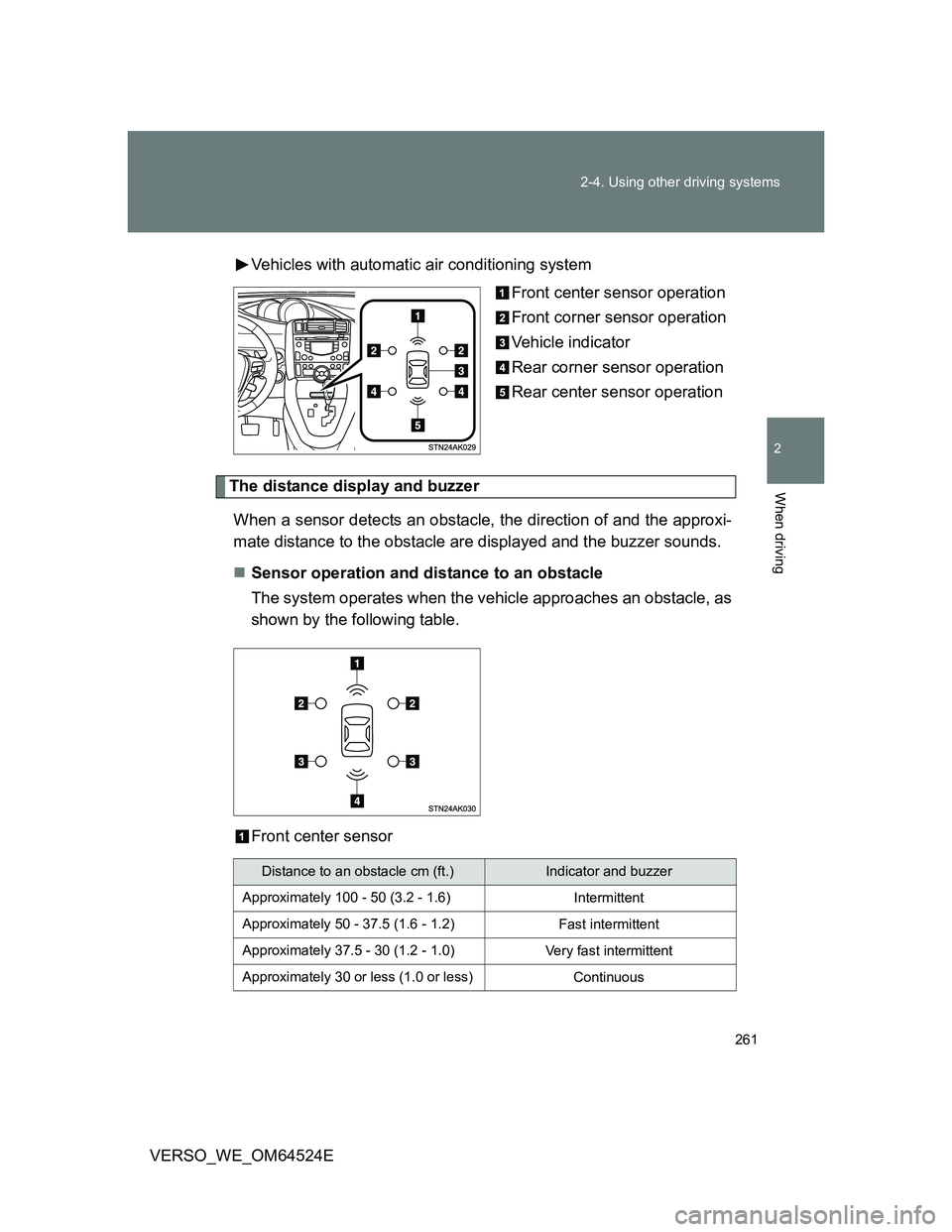
261 2-4. Using other driving systems
2
When driving
VERSO_WE_OM64524EVehicles with automatic air conditioning system
Front center sensor operation
Front corner sensor operation
Vehicle indicator
Rear corner sensor operation
Rear center sensor operation
The distance display and buzzer
When a sensor detects an obstacle, the direction of and the approxi-
mate distance to the obstacle are displayed and the buzzer sounds.
Sensor operation and distance to an obstacle
The system operates when the vehicle approaches an obstacle, as
shown by the following table.
Front center sensor
Distance to an obstacle cm (ft.)Indicator and buzzer
Approximately 100 - 50 (3.2 - 1.6)
Intermittent
Approximately 50 - 37.5 (1.6 - 1.2)
Fast intermittent
Approximately 37.5 - 30 (1.2 - 1.0)
Very fast intermittent
Approximately 30 or less (1.0 or less)
Continuous
Page 262 of 588
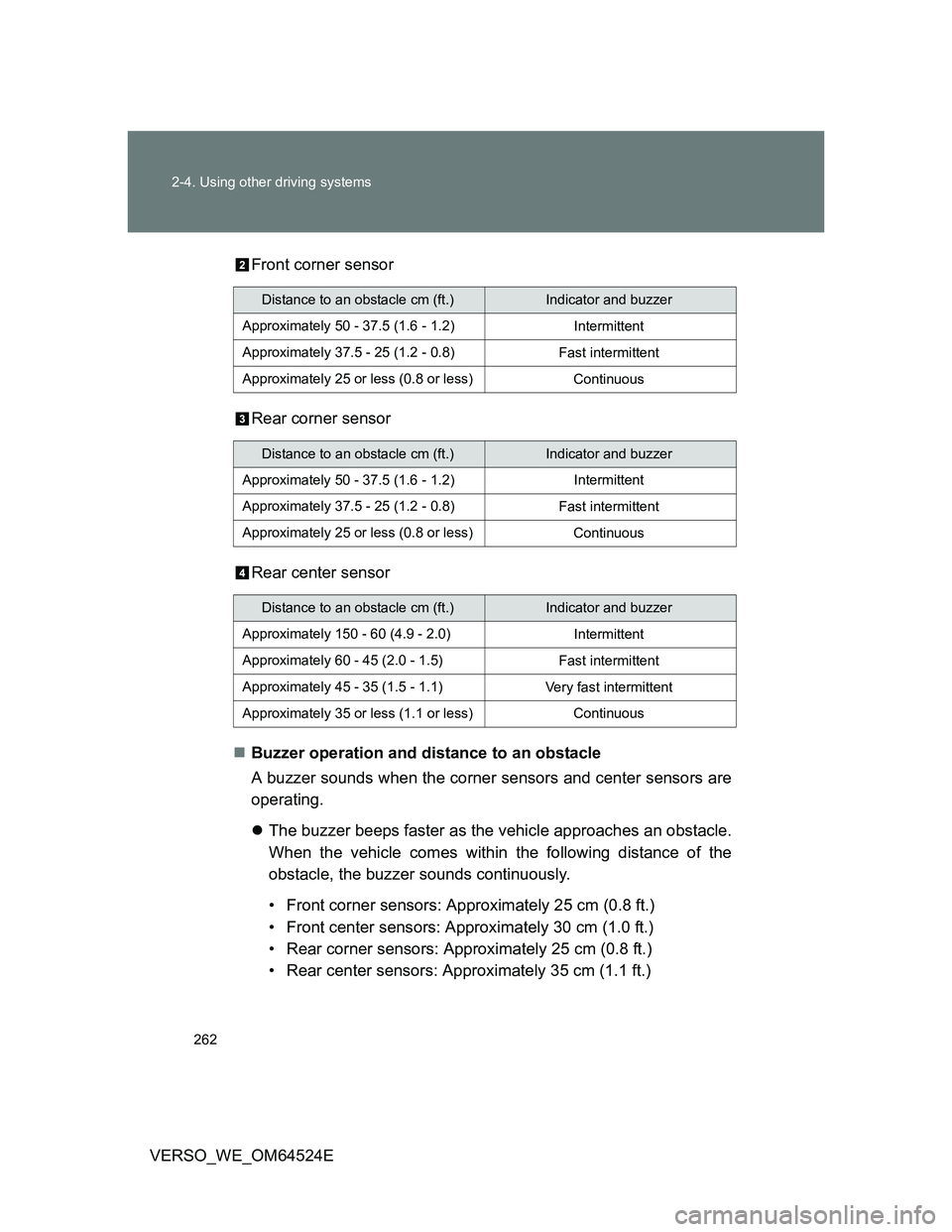
262 2-4. Using other driving systems
VERSO_WE_OM64524EFront corner sensor
Rear corner sensor
Rear center sensor
Buzzer operation and distance to an obstacle
A buzzer sounds when the corner sensors and center sensors are
operating.
The buzzer beeps faster as the vehicle approaches an obstacle.
When the vehicle comes within the following distance of the
obstacle, the buzzer sounds continuously.
• Front corner sensors: Approximately 25 cm (0.8 ft.)
• Front center sensors: Approximately 30 cm (1.0 ft.)
• Rear corner sensors: Approximately 25 cm (0.8 ft.)
• Rear center sensors: Approximately 35 cm (1.1 ft.)
Distance to an obstacle cm (ft.)Indicator and buzzer
Approximately 50 - 37.5 (1.6 - 1.2)
Intermittent
Approximately 37.5 - 25 (1.2 - 0.8)
Fast intermittent
Approximately 25 or less (0.8 or less)
Continuous
Distance to an obstacle cm (ft.)Indicator and buzzer
Approximately 50 - 37.5 (1.6 - 1.2)
Intermittent
Approximately 37.5 - 25 (1.2 - 0.8)
Fast intermittent
Approximately 25 or less (0.8 or less)
Continuous
Distance to an obstacle cm (ft.)Indicator and buzzer
Approximately 150 - 60 (4.9 - 2.0)
Intermittent
Approximately 60 - 45 (2.0 - 1.5)
Fast intermittent
Approximately 45 - 35 (1.5 - 1.1)
Very fast intermittent
Approximately 35 or less (1.1 or less)
Continuous
Page 263 of 588
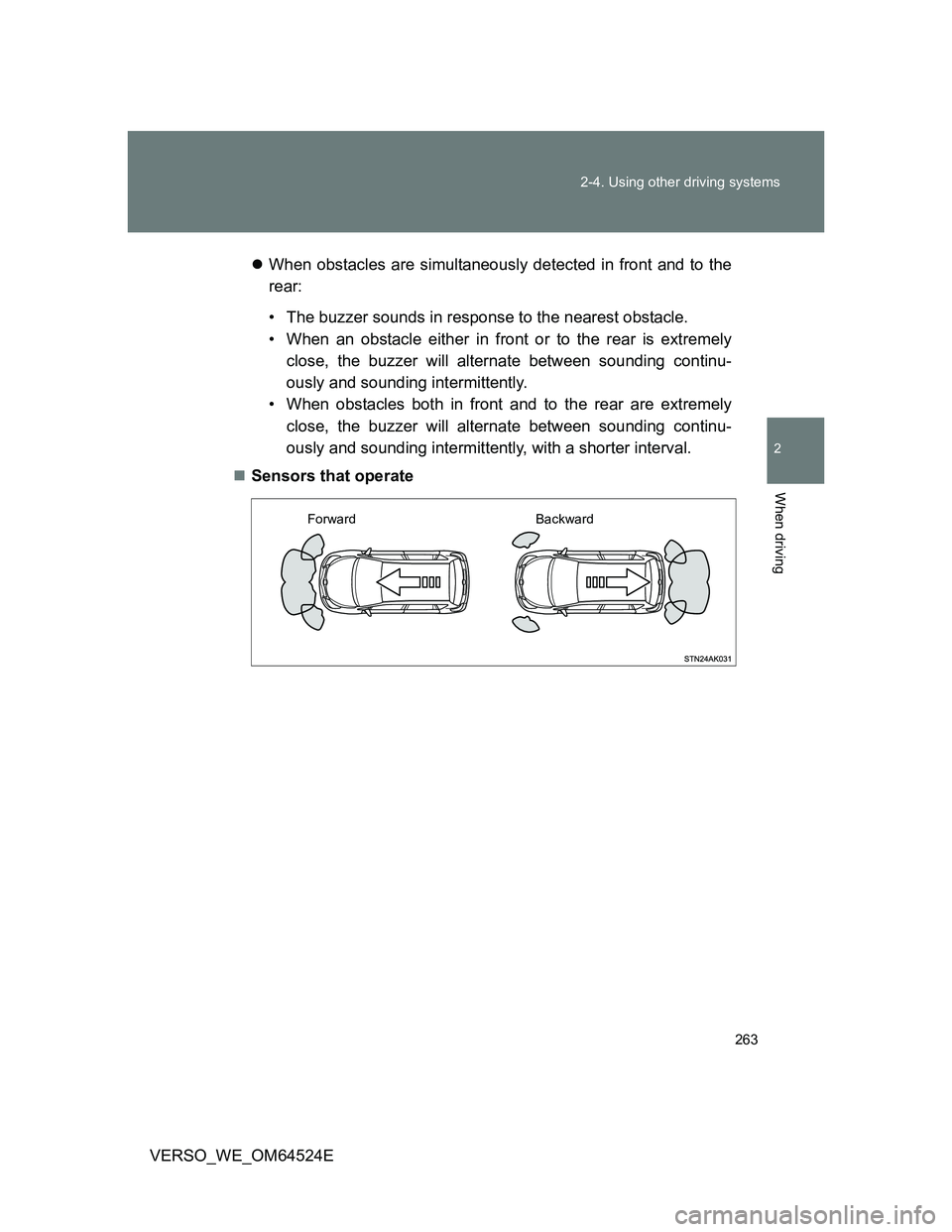
263 2-4. Using other driving systems
2
When driving
VERSO_WE_OM64524EWhen obstacles are simultaneously detected in front and to the
rear:
• The buzzer sounds in response to the nearest obstacle.
• When an obstacle either in front or to the rear is extremely
close, the buzzer will alternate between sounding continu-
ously and sounding intermittently.
• When obstacles both in front and to the rear are extremely
close, the buzzer will alternate between sounding continu-
ously and sounding intermittently, with a shorter interval.
Sensors that operate
Forward Backward
Page 264 of 588
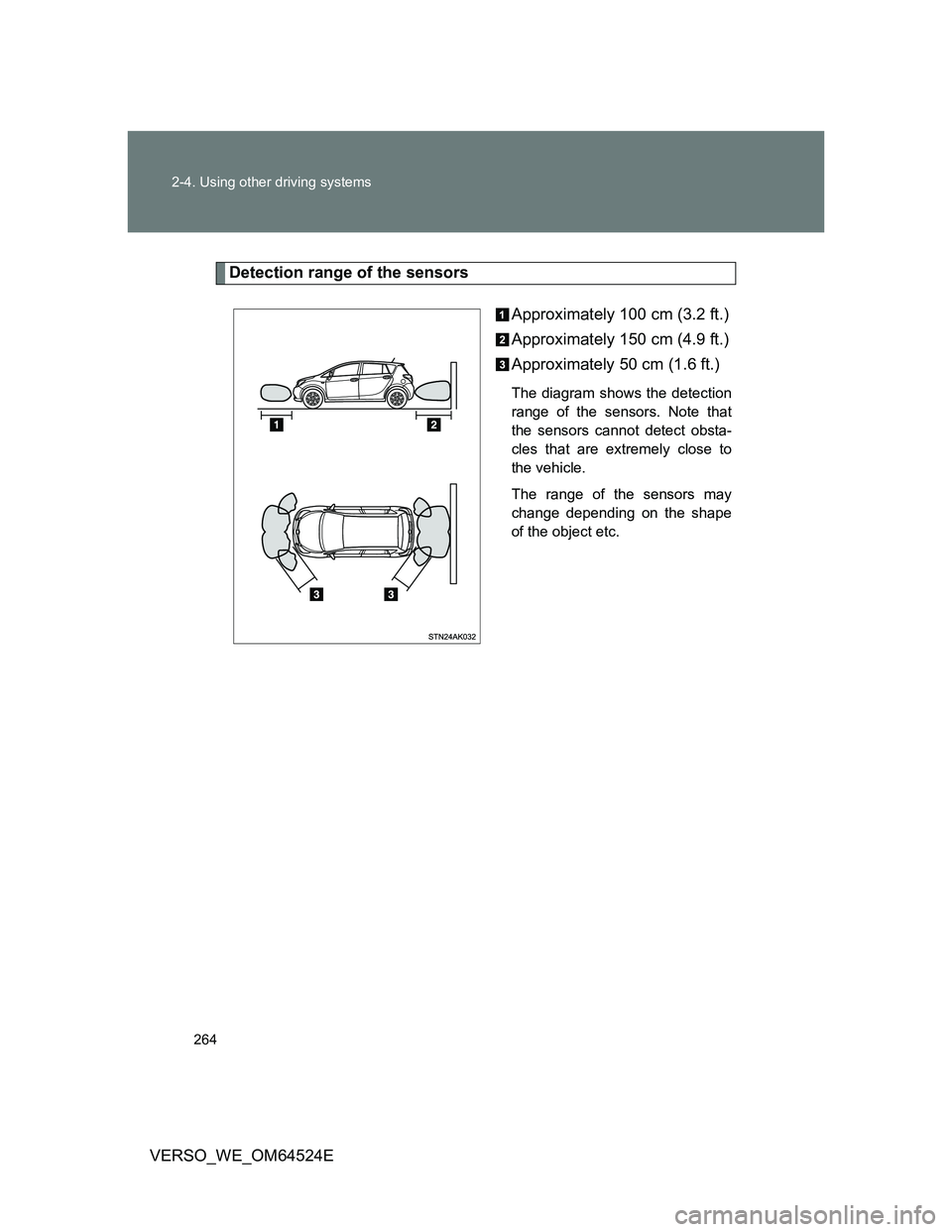
264 2-4. Using other driving systems
VERSO_WE_OM64524E
Detection range of the sensors
Approximately 100 cm (3.2 ft.)
Approximately 150 cm (4.9 ft.)
Approximately 50 cm (1.6 ft.)
The diagram shows the detection
range of the sensors. Note that
the sensors cannot detect obsta-
cles that are extremely close to
the vehicle.
The range of the sensors may
change depending on the shape
of the object etc.
Page 265 of 588
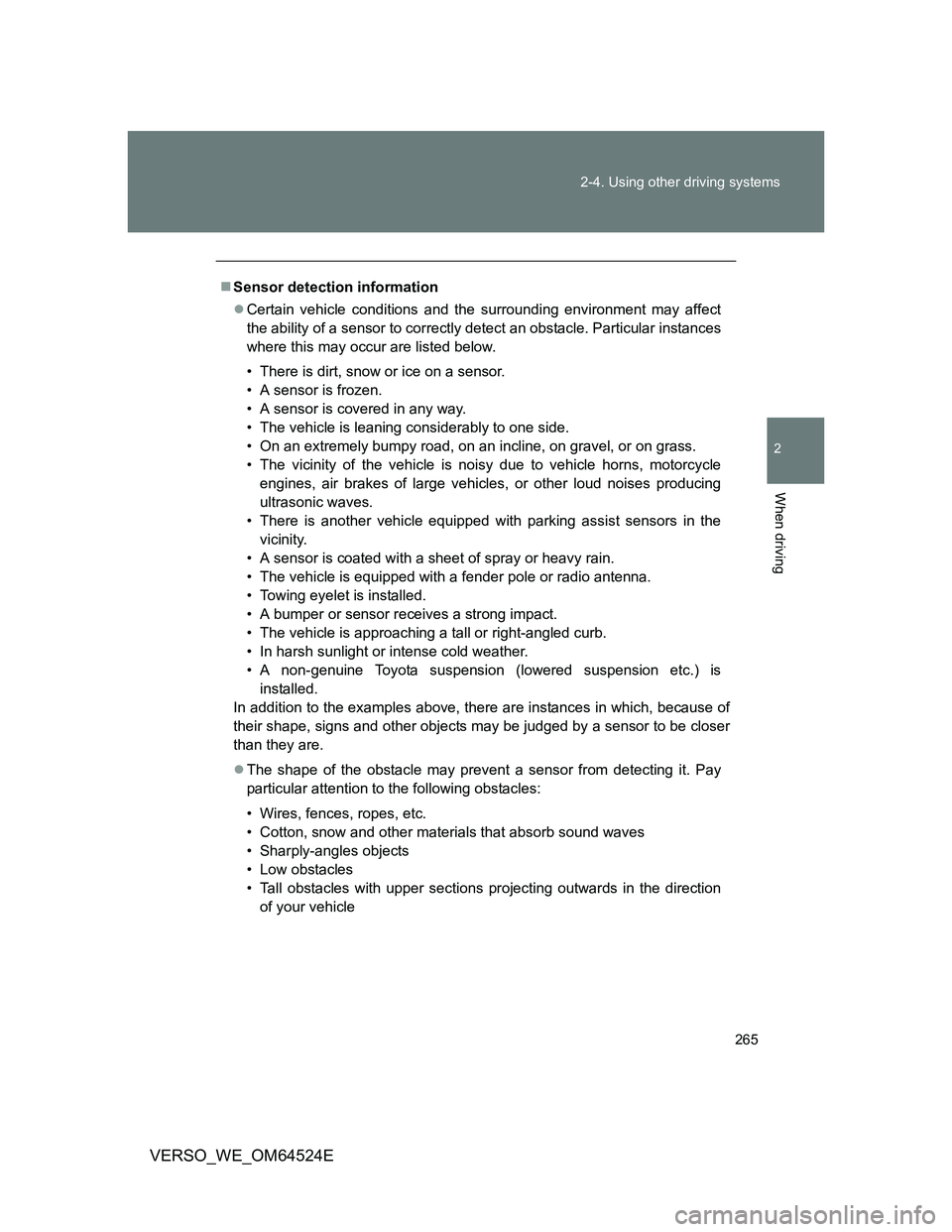
265 2-4. Using other driving systems
2
When driving
VERSO_WE_OM64524E
Sensor detection information
Certain vehicle conditions and the surrounding environment may affect
the ability of a sensor to correctly detect an obstacle. Particular instances
where this may occur are listed below.
• There is dirt, snow or ice on a sensor.
• A sensor is frozen.
• A sensor is covered in any way.
• The vehicle is leaning considerably to one side.
• On an extremely bumpy road, on an incline, on gravel, or on grass.
• The vicinity of the vehicle is noisy due to vehicle horns, motorcycle
engines, air brakes of large vehicles, or other loud noises producing
ultrasonic waves.
• There is another vehicle equipped with parking assist sensors in the
vicinity.
• A sensor is coated with a sheet of spray or heavy rain.
• The vehicle is equipped with a fender pole or radio antenna.
• Towing eyelet is installed.
• A bumper or sensor receives a strong impact.
• The vehicle is approaching a tall or right-angled curb.
• In harsh sunlight or intense cold weather.
• A non-genuine Toyota suspension (lowered suspension etc.) is
installed.
In addition to the examples above, there are instances in which, because of
their shape, signs and other objects may be judged by a sensor to be closer
than they are.
The shape of the obstacle may prevent a sensor from detecting it. Pay
particular attention to the following obstacles:
• Wires, fences, ropes, etc.
• Cotton, snow and other materials that absorb sound waves
• Sharply-angles objects
• Low obstacles
• Tall obstacles with upper sections projecting outwards in the direction
of your vehicle
Page 266 of 588
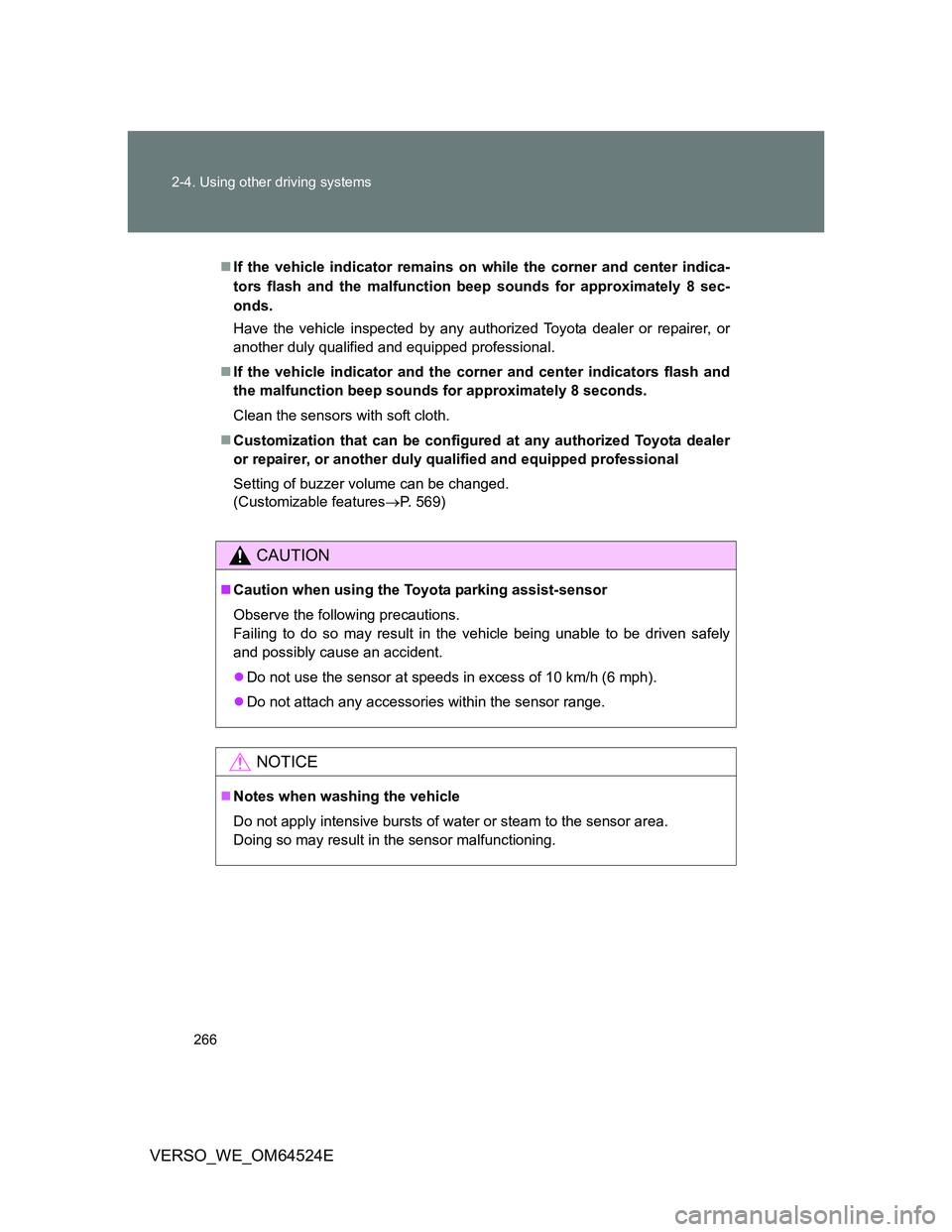
266 2-4. Using other driving systems
VERSO_WE_OM64524E
If the vehicle indicator remains on while the corner and center indica-
tors flash and the malfunction beep sounds for approximately 8 sec-
onds.
Have the vehicle inspected by any authorized Toyota dealer or repairer, or
another duly qualified and equipped professional.
If the vehicle indicator and the corner and center indicators flash and
the malfunction beep sounds for approximately 8 seconds.
Clean the sensors with soft cloth.
Customization that can be configured at any authorized Toyota dealer
or repairer, or another duly qualified and equipped professional
Setting of buzzer volume can be changed.
(Customizable featuresP. 569)
CAUTION
Caution when using the Toyota parking assist-sensor
Observe the following precautions.
Failing to do so may result in the vehicle being unable to be driven safely
and possibly cause an accident.
Do not use the sensor at speeds in excess of 10 km/h (6 mph).
Do not attach any accessories within the sensor range.
NOTICE
Notes when washing the vehicle
Do not apply intensive bursts of water or steam to the sensor area.
Doing so may result in the sensor malfunctioning.
Page 267 of 588
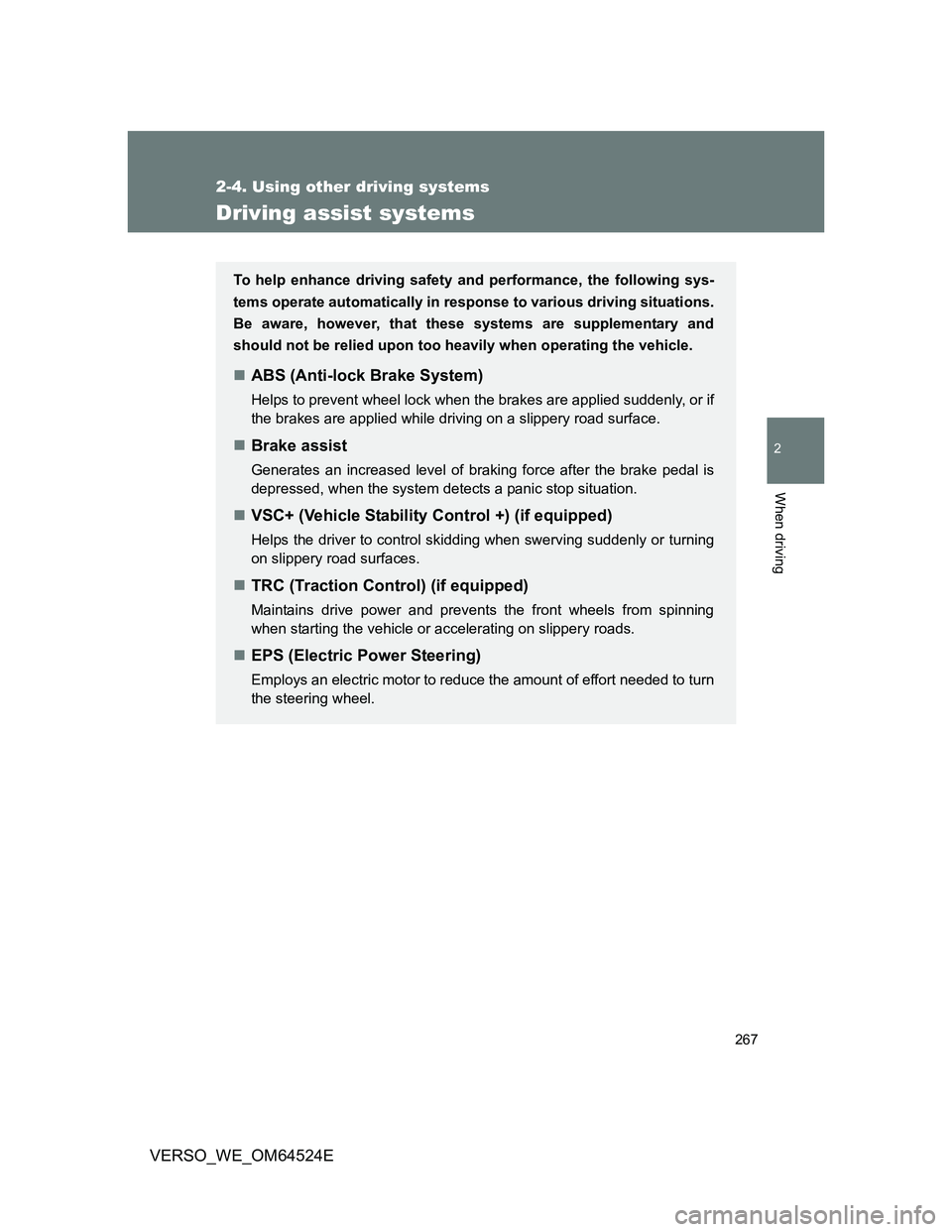
267
2-4. Using other driving systems
2
When driving
VERSO_WE_OM64524E
Driving assist systems
To help enhance driving safety and performance, the following sys-
tems operate automatically in response to various driving situations.
Be aware, however, that these systems are supplementary and
should not be relied upon too heavily when operating the vehicle.
ABS (Anti-lock Brake System)
Helps to prevent wheel lock when the brakes are applied suddenly, or if
the brakes are applied while driving on a slippery road surface.
Brake assist
Generates an increased level of braking force after the brake pedal is
depressed, when the system detects a panic stop situation.
VSC+ (Vehicle Stability Control +) (if equipped)
Helps the driver to control skidding when swerving suddenly or turning
on slippery road surfaces.
TRC (Traction Control) (if equipped)
Maintains drive power and prevents the front wheels from spinning
when starting the vehicle or accelerating on slippery roads.
EPS (Electric Power Steering)
Employs an electric motor to reduce the amount of effort needed to turn
the steering wheel.
Page 268 of 588
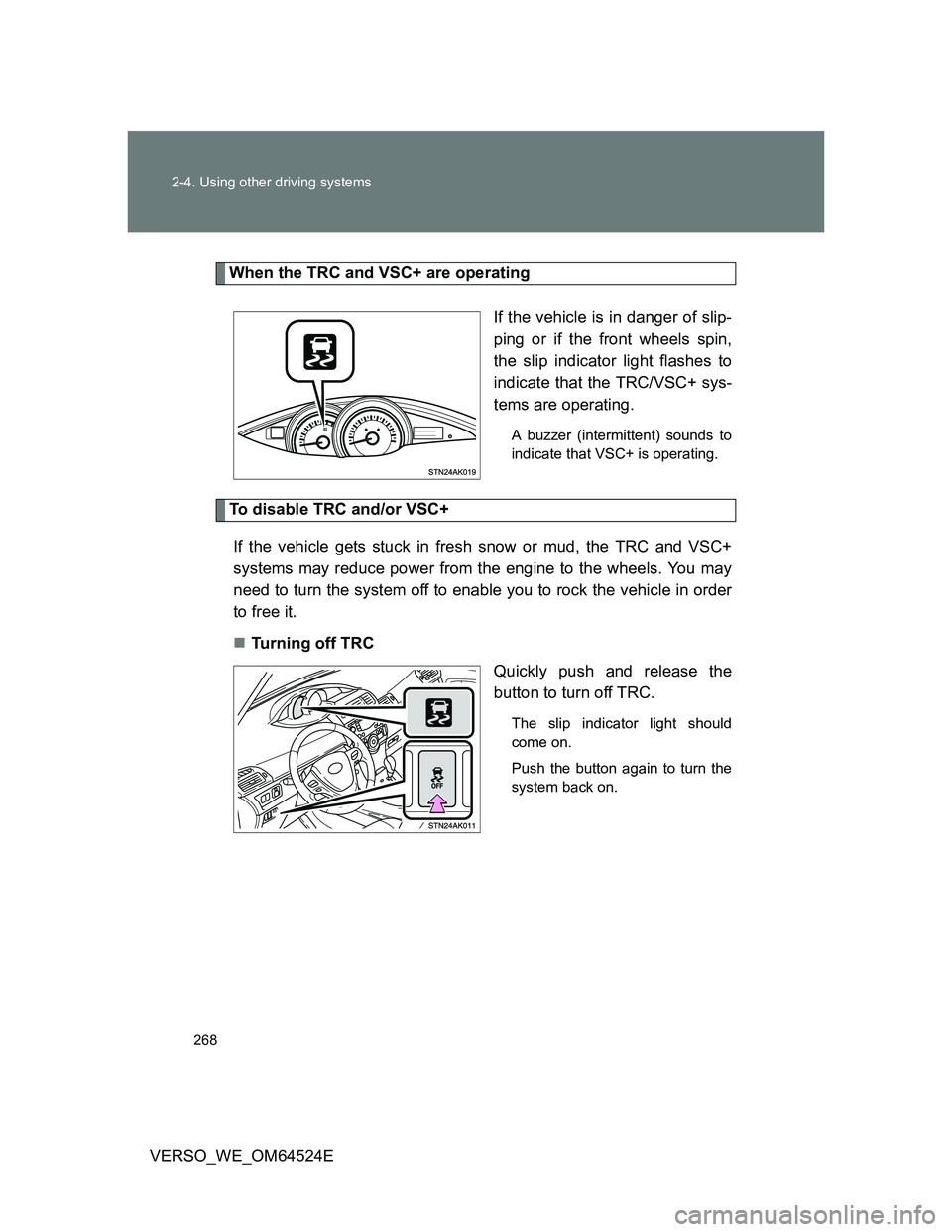
268 2-4. Using other driving systems
VERSO_WE_OM64524E
When the TRC and VSC+ are operating
If the vehicle is in danger of slip-
ping or if the front wheels spin,
the slip indicator light flashes to
indicate that the TRC/VSC+ sys-
tems are operating.
A buzzer (intermittent) sounds to
indicate that VSC+ is operating.
To disable TRC and/or VSC+
If the vehicle gets stuck in fresh snow or mud, the TRC and VSC+
systems may reduce power from the engine to the wheels. You may
need to turn the system off to enable you to rock the vehicle in order
to free it.
Turning off TRC
Quickly push and release the
button to turn off TRC.
The slip indicator light should
come on.
Push the button again to turn the
system back on.
Page 269 of 588
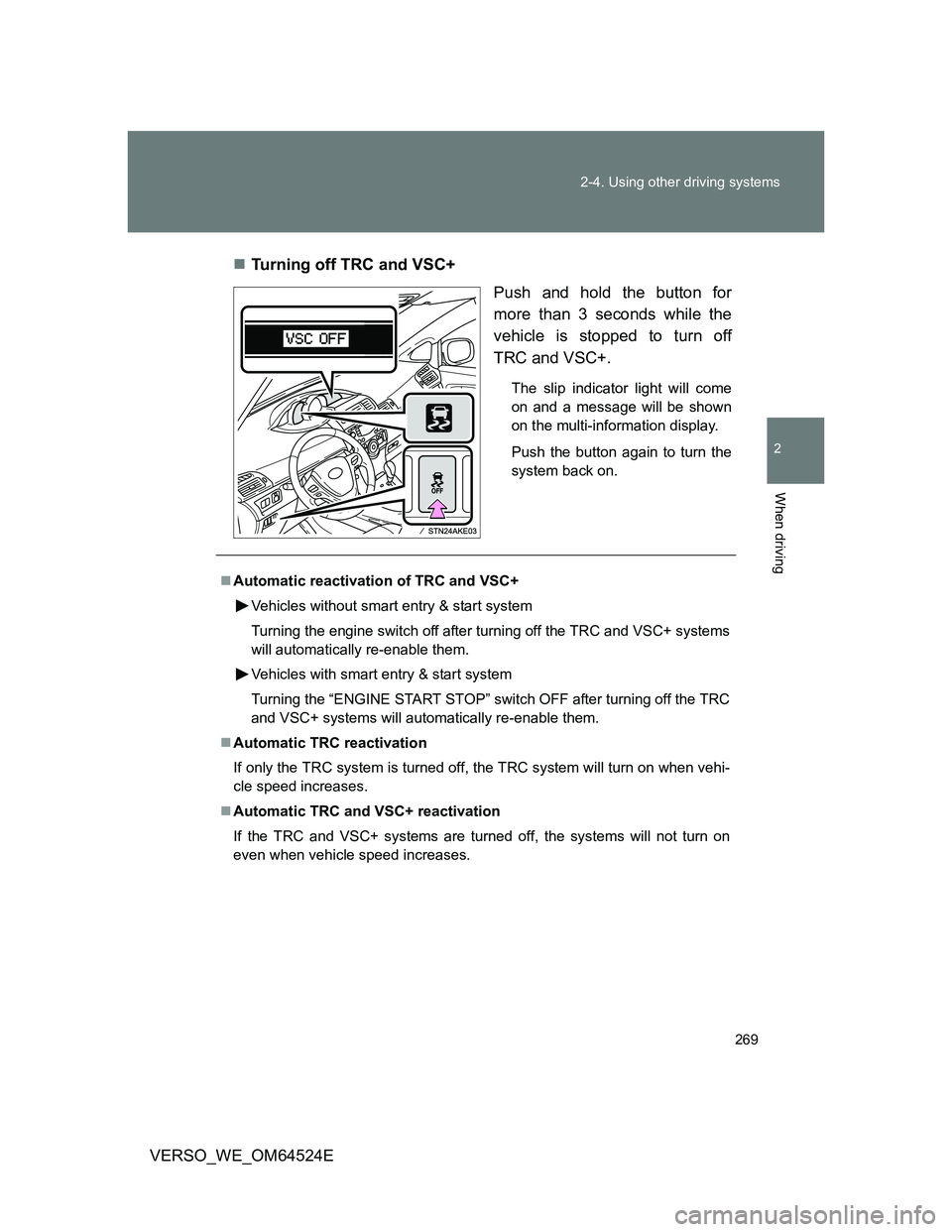
269 2-4. Using other driving systems
2
When driving
VERSO_WE_OM64524ETurning off TRC and VSC+
Push and hold the button for
more than 3 seconds while the
vehicle is stopped to turn off
TRC and VSC+.
The slip indicator light will come
on and a message will be shown
on the multi-information display.
Push the button again to turn the
system back on.
Automatic reactivation of TRC and VSC+
Vehicles without smart entry & start system
Turning the engine switch off after turning off the TRC and VSC+ systems
will automatically re-enable them.
Vehicles with smart entry & start system
Turning the “ENGINE START STOP” switch OFF after turning off the TRC
and VSC+ systems will automatically re-enable them.
Automatic TRC reactivation
If only the TRC system is turned off, the TRC system will turn on when vehi-
cle speed increases.
Automatic TRC and VSC+ reactivation
If the TRC and VSC+ systems are turned off, the systems will not turn on
even when vehicle speed increases.
Page 270 of 588
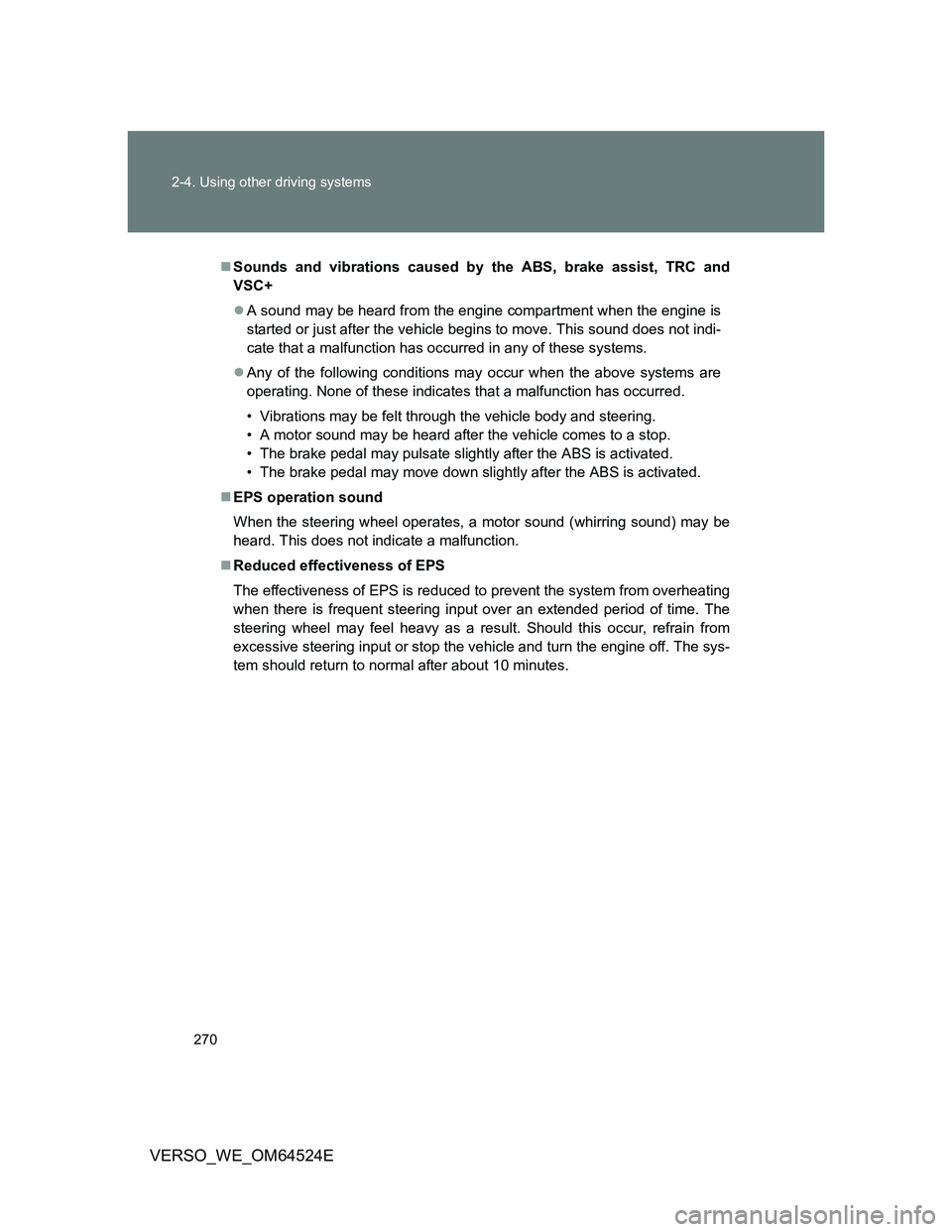
270 2-4. Using other driving systems
VERSO_WE_OM64524E
Sounds and vibrations caused by the ABS, brake assist, TRC and
VSC+
A sound may be heard from the engine compartment when the engine is
started or just after the vehicle begins to move. This sound does not indi-
cate that a malfunction has occurred in any of these systems.
Any of the following conditions may occur when the above systems are
operating. None of these indicates that a malfunction has occurred.
• Vibrations may be felt through the vehicle body and steering.
• A motor sound may be heard after the vehicle comes to a stop.
• The brake pedal may pulsate slightly after the ABS is activated.
• The brake pedal may move down slightly after the ABS is activated.
EPS operation sound
When the steering wheel operates, a motor sound (whirring sound) may be
heard. This does not indicate a malfunction.
Reduced effectiveness of EPS
The effectiveness of EPS is reduced to prevent the system from overheating
when there is frequent steering input over an extended period of time. The
steering wheel may feel heavy as a result. Should this occur, refrain from
excessive steering input or stop the vehicle and turn the engine off. The sys-
tem should return to normal after about 10 minutes.